brake Hyundai Tucson 2019 Owner's Manual - RHD (UK, Australia)
[x] Cancel search | Manufacturer: HYUNDAI, Model Year: 2019, Model line: Tucson, Model: Hyundai Tucson 2019Pages: 685, PDF Size: 17.76 MB
Page 10 of 685

As with other vehicles of this type,
failure to operate this vehicle correct-
ly may result in loss of control, an
accident or vehicle rollover.
Specific design characteristics (high-
er ground clearance, track, etc.) give
this vehicle a higher centre of gravity
than other types of vehicles. In other
words they are not designed for cor-
nering at the same speeds as con-
ventional 2-wheel drive vehicles.
Avoid sharp turns or abrupt manoeu-
vres. Again, failure to operate this
vehicle correctly may result in loss of
control, an accident or vehicle
rollover.Be sure to read the
"Reducing the risk of a rollover"
driving guidelines, in section 5 of
this manual. By following a few simple precautions
for the first 600 miles (1,000 km) you
may add to the performance, econo-
my and life of your vehicle.
• Do not race the engine.
• Whilst driving, keep your engine
speed (rpm, or revolutions per
minute) between 2,000 rpm and
4,000 rpm.
• Do not maintain a single speed for long periods of time, either fast or
slow. Varying engine speed is need-
ed to properly break-in the engine.
• Avoid hard stops, except in emer- gencies, to allow the brakes to seat
properly.
• Don't tow a trailer during the first 1,200 miles (2,000 km) of operation.
F10
Introduction
•Never use any fuel, whether
diesel, B7 biodiesel or other-
wise, that fails to meet the lat-
est petroleum industry speci-
fication.
•Never use any fuel additives
or treatments that are not rec-
ommended or approved by
the vehicle manufacturer.
CAUTION
VEHICLE HANDLING
INSTRUCTIONS
VEHICLE BREAK-IN
PROCESS
TLe UK foreword---.qxp 6/19/2018 4:55 PM Page 10
Page 16 of 685

1-4
Your vehicle at a glance
INTERIOR OVERVIEW
1. Door lock/unlock button ......................3-16
2. Power window switches*.....................3-32
3. Central door lock switch* ...................3-17
4. Power window lock switch* .................3-35
5. Outside rearview mirror controlswitch*.................................................3-30
6. Outside rearview mirror folding button*.................................................3-31
7. Headlight levelling device* ................3-118
8. Instrument panel illumination control switch*.....................................3-62
9. Blind-spot Collision Warning (BCW) system* .............................................5-101
10. Lane Keeping Assist (LKA) system* .5-109
11. 4WD lock button* ..............................5-68
12. ESC OFF button* ..............................5-58
13. Power tailgate button* .......................3-49
14. Fuse box ...........................................7-54
15. Steering wheel ..................................3-22
16. Ignition switch........................................5-6
17. Seat ....................................................2-4
18. Bonnet release lever .........................3-42
19. Brake pedal.......................................5-43
20. Accelerator pedal
* : if equipped
OTLE018003RThe actual shape may differ from the illustration.
TLe UK 1.qxp 5/10/2018 11:27 AM Page 4
Page 18 of 685
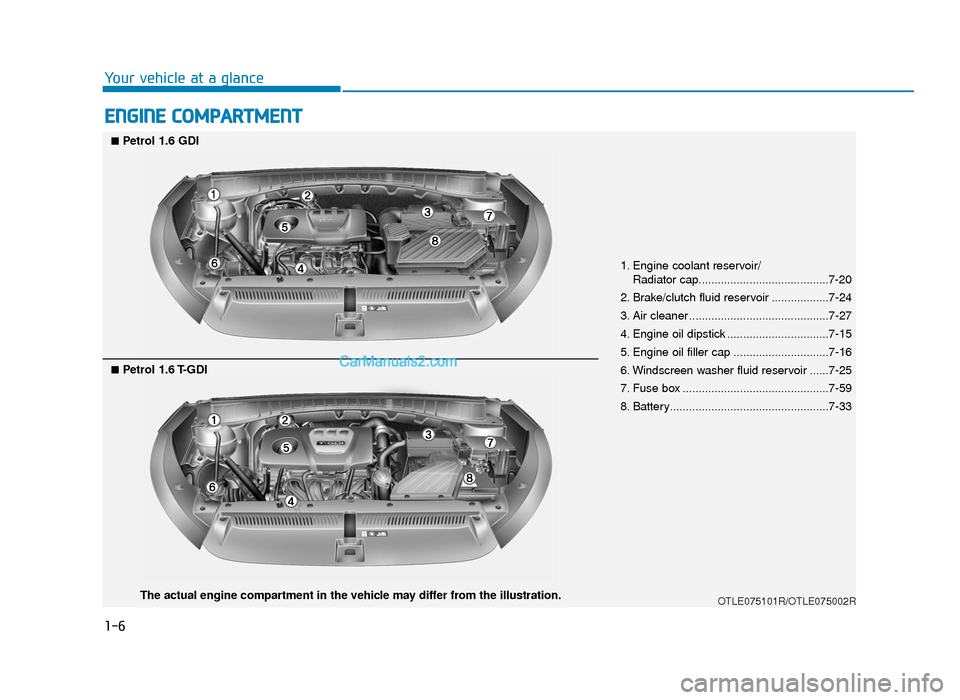
1-6
Your vehicle at a glance
ENGINE COMPARTMENT
1. Engine coolant reservoir/Radiator cap.........................................7-20
2. Brake/clutch fluid reservoir ..................7-24
3. Air cleaner ............................................7-27
4. Engine oil dipstick ................................7-15
5. Engine oil filler cap ..............................7-16
6. Windscreen washer fluid reservoir ......7-25
7. Fuse box ..............................................7-59
8. Battery..................................................7-33
OTLE075101R/OTLE075002R
■Petrol 1.6 GDI
■Petrol 1.6 T-GDI
The actual engine compartment in the vehicle may differ from the illustration.
TLe UK 1.qxp 5/10/2018 11:28 AM Page 6
Page 19 of 685
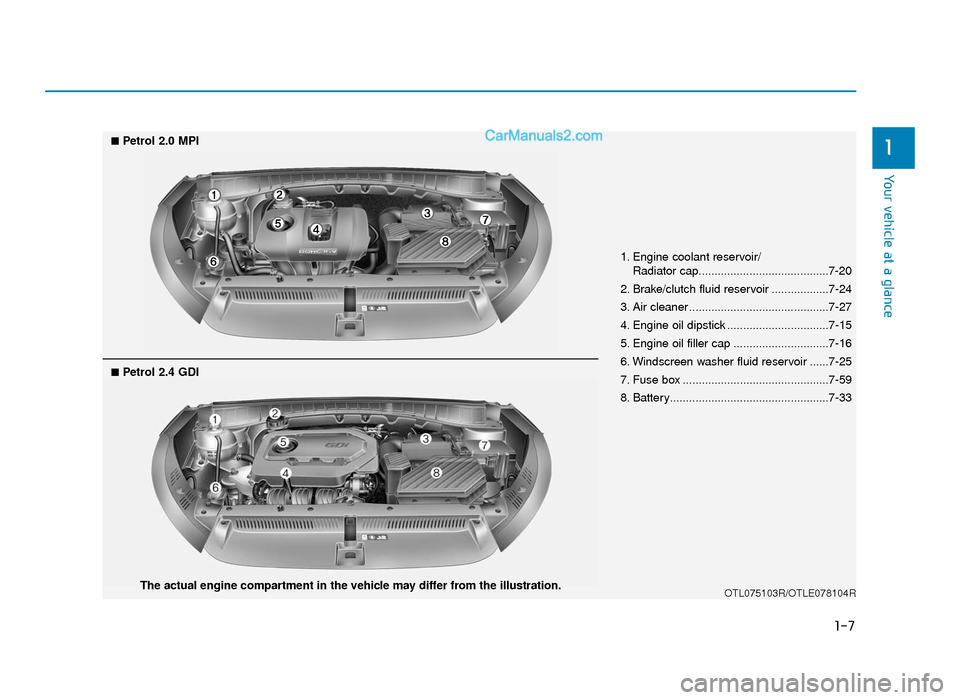
1-7
Your vehicle at a glance
1
1. Engine coolant reservoir/Radiator cap.........................................7-20
2. Brake/clutch fluid reservoir ..................7-24
3. Air cleaner ............................................7-27
4. Engine oil dipstick ................................7-15
5. Engine oil filler cap ..............................7-16
6. Windscreen washer fluid reservoir ......7-25
7. Fuse box ..............................................7-59
8. Battery..................................................7-33
OTL075103R/OTLE078104R
■Petrol 2.0 MPI
■Petrol 2.4 GDI
The actual engine compartment in the vehicle may differ from the illustration.
TLe UK 1.qxp 5/10/2018 11:28 AM Page 7
Page 20 of 685

1-8
Your vehicle at a glance
1. Engine coolant reservoir/Radiator cap.........................................7-20
2. Brake/clutch fluid reservoir ..................7-24
3. Air cleaner ............................................7-27
4. Engine oil dipstick ................................7-17
5. Engine oil filler cap ..............................7-18
6. Windscreen washer fluid reservoir ......7-25
7. Fuse box ..............................................7-59
8. Battery..................................................7-33
9. Fuel filter .............................................7-26
OTLE078002/OTLE078001R
■Smartstream D1.6
■Diesel 2.0 TCI / Diesel 2.0 48V MHEV
The actual engine compartment in the vehicle may differ from the illustration.
TLe UK 1.qxp 5/10/2018 11:28 AM Page 8
Page 34 of 685

2-14
5. To use the rear seat, lift and pushthe seatback rearward by lifting up
the front portion of the folding
lever.
Push the seatback firmly until it
clicks into place. Make sure the
seatback is locked in place.
Safety system of your vehicle
OTLE035025
Do not place objects in the rear
seats, since they cannot be
properly secured and may hit
vehicle occupants in a collision
causing serious injury or death.
WARNING
When returning the rear seat-
back from a folded to an upright
position, hold the seatback and
return it slowly. Ensure that the
seatback is completely locked
into its upright position by
pushing on the top of the seat-
back. In an accident or sudden
stop, the unlocked seatback
could allow cargo to move for-
ward with great force and enter
the passenger compartment,
which could result in serious
injury or death.
WARNING
Make sure the engine is off, the
shift lever is in P (Park), and the
parking brake is securely
applied whenever loading or
unloading cargo. Failure to take
these steps may allow the vehi-
cle to move if the shift lever is
inadvertently moved to another
position.
WARNING
TLe UK 2.qxp 6/12/2018 2:04 PM Page 14
Page 87 of 685
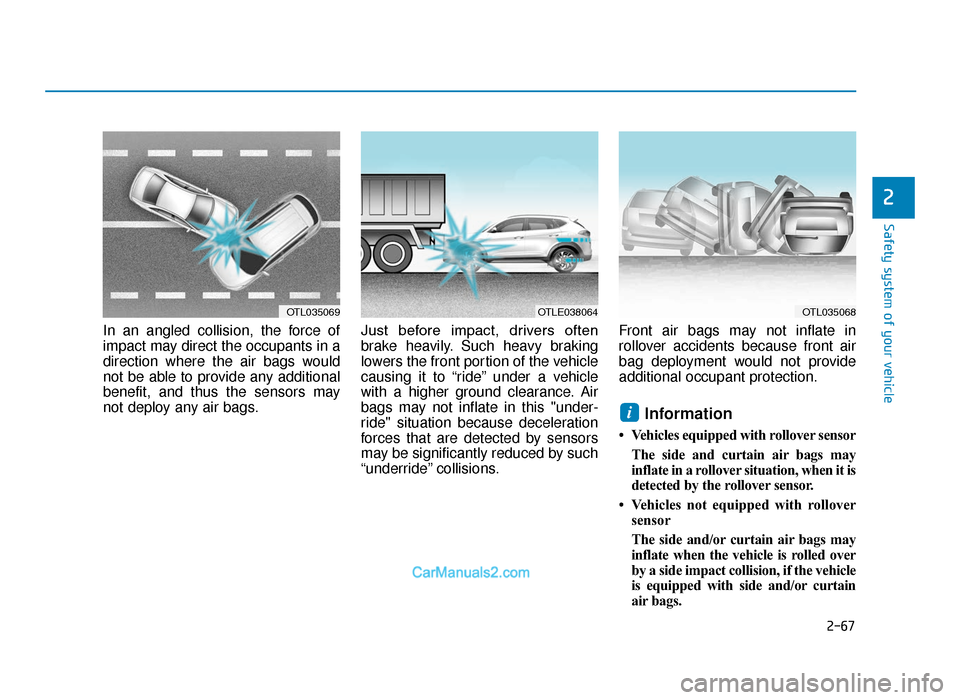
2-67
Safety system of your vehicle
2
In an angled collision, the force of
impact may direct the occupants in a
direction where the air bags would
not be able to provide any additional
benefit, and thus the sensors may
not deploy any air bags.Just before impact, drivers often
brake heavily. Such heavy braking
lowers the front portion of the vehicle
causing it to “ride” under a vehicle
with a higher ground clearance. Air
bags may not inflate in this "under-
ride" situation because deceleration
forces that are detected by sensors
may be significantly reduced by such
“underride” collisions.Front air bags may not inflate in
rollover accidents because front air
bag deployment would not provide
additional occupant protection.
Information
• Vehicles equipped with rollover sensor
The side and curtain air bags may
inflate in a rollover situation, when it is
detected by the rollover sensor.
• Vehicles not equipped with rollover sensor
The side and/or curtain air bags may
inflate when the vehicle is rolled over
by a side impact collision, if the vehicle
is equipped with side and/or curtain
air bags.
i
OTL035069OTLE038064OTL035068
TLe UK 2.qxp 6/12/2018 2:09 PM Page 67
Page 109 of 685

3-17
Convenient features of your vehicle
3
With the central door lock switch
When pressing the ( ) portion (1) of
the switch, all vehicle doors will lock.
• If any door is opened, the doorswill not lock even though the lock
button (1) of the central door lock
switch is pressed.
• If the smart key is in the vehicle and any door is opened, the doors
will not lock even though the lock
button (1) of the central door lock
switch is pressed.
When pressing the ( ) portion (2) of
the switch, all vehicle doors will unlock.
OTLE045006
•The doors should always be
fully closed and locked whilst
the vehicle is in motion. If the
doors are unlocked, the risk of
being thrown from the vehicle
in a crash is increased.
•Do not pull the inner door han-
dle of the driver’s or passen-
ger’s door whilst the vehicle is
moving.
WARNING
Do not leave children or animals
unattended in your vehicle. An
enclosed vehicle can become
extremely hot, causing death or
serious injury to unattended
children or animals who cannot
escape the vehicle. Children
might operate features of the
vehicle that could injure them,
or they could encounter other
harm, possibly from someone
gaining entry to the vehicle.
WARNING
Leaving your vehicle unlocked
increases the potential risk to
you or others from someone
hiding in your vehicle.
To secure your vehicle, whilst
depressing the brake, move the
shift lever to the P (Park) posi-
tion (for automatic transaxle/
dual clutch transmission) or first
gear or R (Reverse, for manual
transaxle), engage the parking
brake, and place the ignition
switch in the LOCK/OFF posi-
tion, close all windows, lock all
doors, and always take the key
with you.
WARNING
TLe UK 3a(~109).qxp 6/12/2018 2:21 PM Page 17
Page 134 of 685
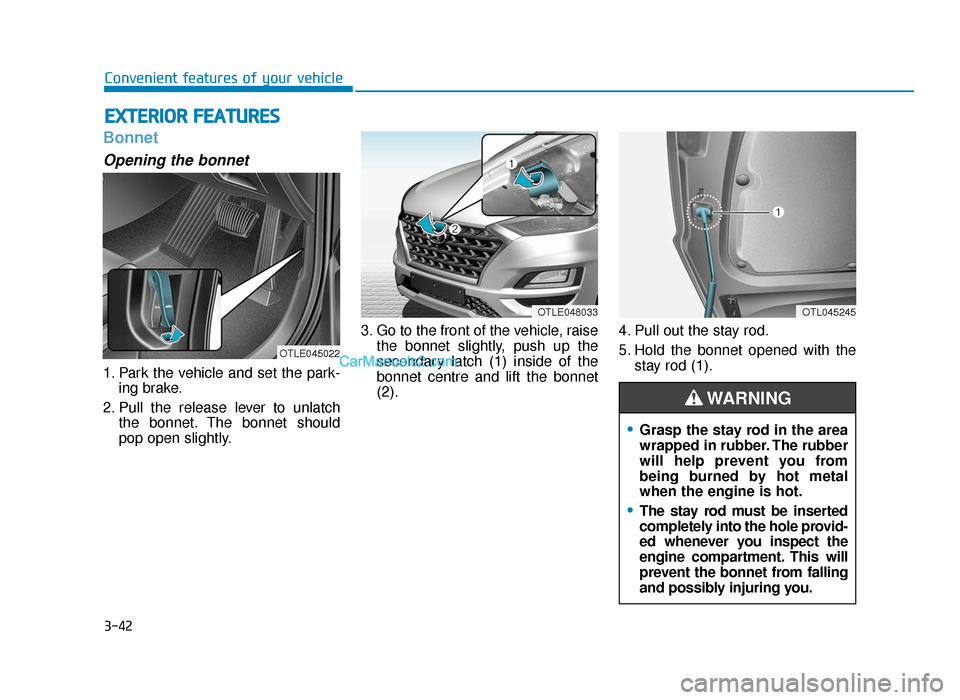
3-42
Convenient features of your vehicle
Bonnet
Opening the bonnet
1. Park the vehicle and set the park-ing brake.
2. Pull the release lever to unlatch the bonnet. The bonnet should
pop open slightly. 3. Go to the front of the vehicle, raise
the bonnet slightly, push up the
secondary latch (1) inside of the
bonnet centre and lift the bonnet
(2). 4. Pull out the stay rod.
5. Hold the bonnet opened with the
stay rod (1).
EXTERIOR FEATURES
OTLE048033OTL045245
OTLE045022
•Grasp the stay rod in the area
wrapped in rubber. The rubber
will help prevent you from
being burned by hot metal
when the engine is hot.
•The stay rod must be inserted
completely into the hole provid-
ed whenever you inspect the
engine compartment. This will
prevent the bonnet from falling
and possibly injuring you.
WARNING
TLe UK 3a(~109).qxp 6/12/2018 2:23 PM Page 42
Page 137 of 685
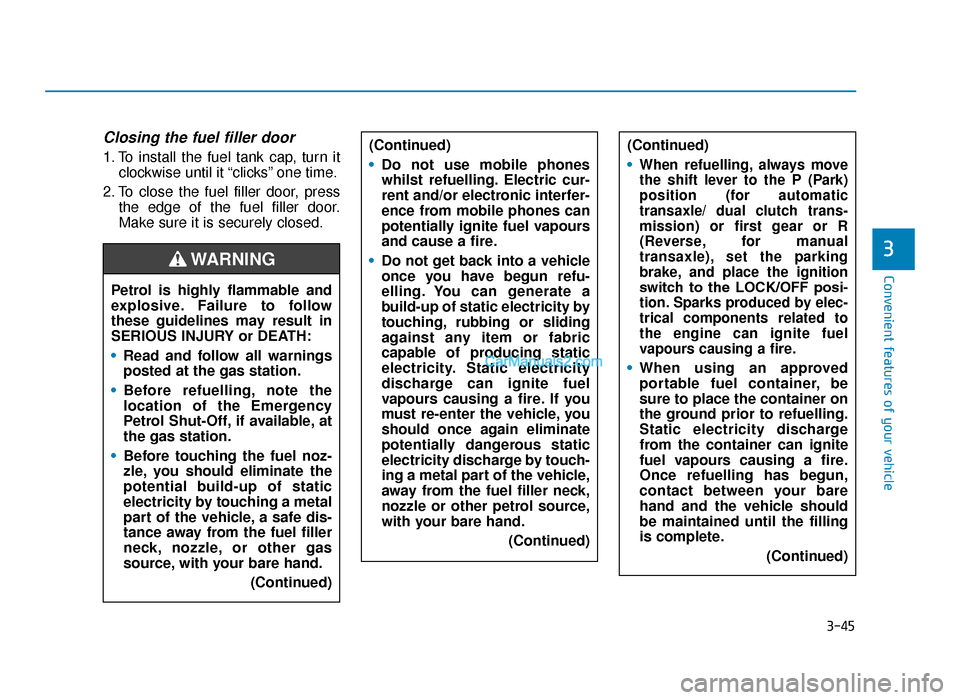
3-45
Convenient features of your vehicle
Closing the fuel filler door
1. To install the fuel tank cap, turn itclockwise until it “clicks” one time.
2. To close the fuel filler door, press the edge of the fuel filler door.
Make sure it is securely closed.
3
Petrol is highly flammable and
explosive. Failure to follow
these guidelines may result in
SERIOUS INJURY or DEATH:
•Read and follow all warnings
posted at the gas station.
• Before refuelling, note the
location of the Emergency
Petrol Shut-Off, if available, at
the gas station.
• Before touching the fuel noz-
zle, you should eliminate the
potential build-up of static
electricity by touching a metal
part of the vehicle, a safe dis-
tance away from the fuel filler
neck, nozzle, or other gas
source, with your bare hand.
(Continued)
WARNING
(Continued)
•Do not use mobile phones
whilst refuelling. Electric cur-
rent and/or electronic interfer-
ence from mobile phones can
potentially ignite fuel vapours
and cause a fire.
• Do not get back into a vehicle
once you have begun refu-
elling. You can generate a
build-up of static electricity by
touching, rubbing or sliding
against any item or fabric
capable of producing static
electricity. Static electricity
discharge can ignite fuel
vapours causing a fire. If you
must re-enter the vehicle, you
should once again eliminate
potentially dangerous static
electricity discharge by touch-
ing a metal part of the vehicle,
away from the fuel filler neck,
nozzle or other petrol source,
with your bare hand.
(Continued)(Continued)
•
When refuelling, always move
the shift lever to the P (Park)
position (for automatic
transaxle/
dual clutch trans-
mission) or first gear or R
(Reverse, for manual
transaxle), set the parking
brake, and place the ignition
switch to the LOCK/OFF posi-
tion. Sparks produced by elec-
trical components related to
the engine can ignite fuel
vapours causing a fire.
• When using an approved
portable fuel container, be
sure to place the container on
the ground prior to refuelling.
Static electricity discharge
from the container can ignite
fuel vapours causing a fire.
Once refuelling has begun,
contact between your bare
hand and the vehicle should
be maintained until the filling
is complete.
(Continued)
TLe UK 3a(~109).qxp 6/12/2018 2:24 PM Page 45